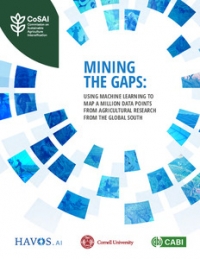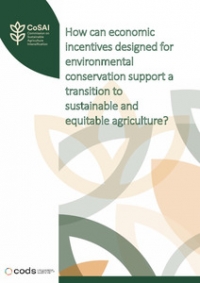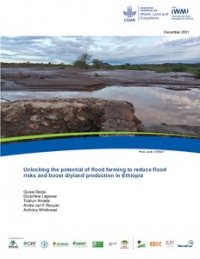Over two billion people already live in areas experiencing high water stress, and that number is expected to grow as a combination of climate change, population growth and unsustainable production and consumption patterns takes its toll. At the heart of the unfolding crisis is food production, which currently accounts for around 70% of global water withdrawals and can reach more than 90% in agrarian economies. Getting agricultural water use right is essential to strengthening both water and food security worldwide – a key prerequisite for sustainable development and resilient societies.
However, past measures to increase water productivity have delivered mixed results, providing tangible benefits in some areas while simultaneously producing negative outcomes in others. For example, improvements in irrigation efficiency have often paradoxically resulted in an overall rise in agricultural water consumption, taking water from other users (notably the environment) and further exacerbating water scarcity.
Now, these and other lessons learned from water productivity interventions worldwide have been distilled into a WASAG White Paper which sets out six key principles to guide policy makers' efforts to strengthen water and food security.
1. Invest in monitoring and hydrological assessments
Data on available water resources are often too scarce and unreliable, undermining the development of effective policies and plans to improve productivity. In developing countries in particular, declining funding has led to considerable uncertainty about the scale of available resources and current patterns of water use. Sustained investments in monitoring of key hydrological and meteorological parameters, including return flows from agricultural water use, and water accounting systems are needed to enable policy makers and managers to assess the performance of current systems and proposed interventions.
2. Set consumption limits
Given agriculture's crucial role in providing food security, employment and income in many countries, the greatest water allocations within a given basin will often be directed at that sector. However, policy makers need to be aware of all water uses and the irrigation efficiency paradox while planning future developments. While improved efficiency may create immediate water savings at the farm level, this may not translate into resource conservation and more water availability for other users (including the environment) within the same basin. Farmers often use the newly freed up 'additional' water to grow more water-intensive crops, intensify production, or expand the amount of land under irrigation.
In this context, maximum water consumption limits (instead of withdrawal rates) should be set and enforced across various water-using sectors within the basin context.
3. Adopt a systems approach
The impacts of interventions at the farm or landscape level are often influenced by broader dynamics. To minimize unintended consequences and maximize synergies, decision makers need to adopt a holistic perspective that takes into account the wider natural and human systems involved and their interactions. Managing water efficiently will require a systemic approach involving a higher degree of coordination and collaboration across traditional administrative divisions.
4. Understand and manage trade-offs and synergies
Water productivity interventions can have a range of different objectives, including reducing agricultural water consumption, increasing farmer incomes, or making more water available for downstream users. These objectives can sometimes be in conflict, as can the interests of different actors within a basin. Thus, tradeoffs between meeting the objectives of farmers, urban residents, factory owners and environmentalists are inevitable.
The challenge is to understand the potential trade-offs and synergies between actors, integrate them into the design of interventions, and then actively manage these. Successful water productivity interventions require a coherent policy framework that supports the water, energy, food and environmental security objectives of governments, with each policy objective given its own instrument.
5. Maximize and share benefits in agriculture
Particularly in low- and middle-income countries, the agricultural sector is the bedrock of national employment and food security. Policy makers need to determine how, within set consumption limits and considering sustainability objectives, the benefits of water productivity improvements can be maximized for farming communities and other water users, especially for the most vulnerable members of those communities (e.g., women, youth, marginalized groups).
6. Learn and evaluate
All water productivity interventions are social experiments that aim to change human behaviour. This means that their dynamics and outcomes are not always certain. Thus, learning and evaluation processes should be incorporated into the implementation process, and be used to inform adjustments in intervention design and management.
Conclusion
Water resources are being placed under an unprecedented amount of stress especially in the context of climate change. This calls for an urgent response to achieve improved, more resilient and more sustainable agricultural water management. Policy makers should ensure that their efforts adhere to the six principles outlined above to strengthen both water and food security.
The WASAG White Paper and its six principles are based on worldwide experiences with water productivity schemes gathered during a workshop of the Global Framework on Water Scarcity in Agriculture (WASAG) co-hosted by the International Center for Advanced Mediterranean Agronomic Studies (CIHEAM) and the CGIAR Research Program on Water, Land and Ecosystems (WLE). It was published by the Food and Agriculture Organization of the United Nations (FAO) in collaboration with the International Water Management Institute (IWMI). Financial support from the Federal Office for Agriculture (FOAG) of the Government of Switzerland and WLE is gratefully acknowledged.
---
Thrive blog is a space for independent thought and aims to stimulate discussion among sustainable agriculture researchers and the public. Blogs are facilitated by the CGIAR Research Program on Water, Land and Ecosystems (WLE) but reflect the opinions and information of the authors only and not necessarily those of WLE and its donors or partners.
WLE and partners are supported by CGIAR Trust Fund Contributors, including: ACIAR, DGIS, FCDO, SDC, Sida and others.

























